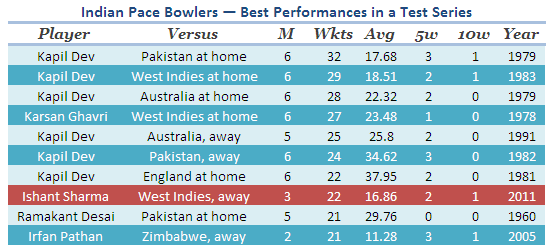
Richard Hadlee had four keywords to good fast bowling: rhythm, off-stump, desire and Lillee. The first three are self-explanatory.As for the fourth, Hadlee said he would think of Dennis Lillee whenever things got tough. “What would Lillee do in this situation? And he would never ever give up,” he explained.Ishant Sharma’s bowling in the Test series in the Caribbean ticks most points on Hadlee’s list. The results are Hadlee-esque, too.In the West Indies, we saw an Ishant we haven’t seen in a long time. It was a synergy between an uncluttered mind, tireless legs, cocked wrist, fingers wrapping the seam, unruly hair in the wind, and the cricket ball.They fused into one efficient machine whose singular objective was to zone in on a spot outside the off-stump. The ball would land on the spot, rear up and ask the batsman an unkind question: are you good enough to handle me?The answer to that lies in Ishant's numbers for the series. His 22 wickets, one every 34 balls, are the most any Indian pace bowler has taken in a three-Test series.Excluding Irfan Pathan’s windfall against a B-grade Zimbabwe, this is the only time an Indian pacer has had such a rich haul since Kapil Dev against West Indies in the 1983 home series (See table).
 The credentials of West Indies’ current side were less than ideal, but not so Ishant’s methods.Ishant bowled fewer no-balls. He was difficult to score off. An ironed-out, smooth run-up preceded a well-coordinated jump into the bowling stride. One, which looked like it was meant to generate hostile pace and bounce. Spell after spell, tirelessly.Rhythm. Off-stump. Desire.It's something you can't attribute to many Indian pacers, especially when they bowl overseas.It turns out his Lillee was Zaheer. Thankfully, he realised aping Zaheer will not work for him.It's his stint alongside Dale Steyn at Deccan Chargers that has triggered a turnaround after being left out of the World Cup squad. An astonishing fiver against Kochi showed us for the first time that Ishant can run through a side. It was the in-cutter that caused problems for batsmen on that day.Deccan coach Darren Lehmann said, "If he is not in the Indian team, then I am a poor selector. He's been unbelievable this year."Interestingly, it was during the first IPL when Ishant showed first signs of losing the edge he had in Australia, particularly in that tireless spell at the end of which he got Ricky Ponting in Perth.Things have come a full circle. After a long time, Ishant has a bagful of wickets to show he's a strike bowler not just on paper. The XXXL-sized, serious-looking, big-nosed, bearded, long-haired, demon fast bowler from India. One, who can also look the part. Watch out, England.
The credentials of West Indies’ current side were less than ideal, but not so Ishant’s methods.Ishant bowled fewer no-balls. He was difficult to score off. An ironed-out, smooth run-up preceded a well-coordinated jump into the bowling stride. One, which looked like it was meant to generate hostile pace and bounce. Spell after spell, tirelessly.Rhythm. Off-stump. Desire.It's something you can't attribute to many Indian pacers, especially when they bowl overseas.It turns out his Lillee was Zaheer. Thankfully, he realised aping Zaheer will not work for him.It's his stint alongside Dale Steyn at Deccan Chargers that has triggered a turnaround after being left out of the World Cup squad. An astonishing fiver against Kochi showed us for the first time that Ishant can run through a side. It was the in-cutter that caused problems for batsmen on that day.Deccan coach Darren Lehmann said, "If he is not in the Indian team, then I am a poor selector. He's been unbelievable this year."Interestingly, it was during the first IPL when Ishant showed first signs of losing the edge he had in Australia, particularly in that tireless spell at the end of which he got Ricky Ponting in Perth.Things have come a full circle. After a long time, Ishant has a bagful of wickets to show he's a strike bowler not just on paper. The XXXL-sized, serious-looking, big-nosed, bearded, long-haired, demon fast bowler from India. One, who can also look the part. Watch out, England.









